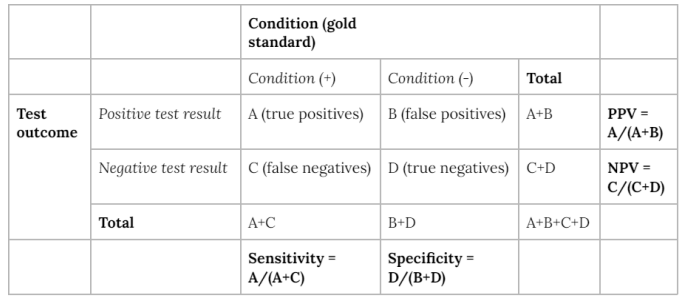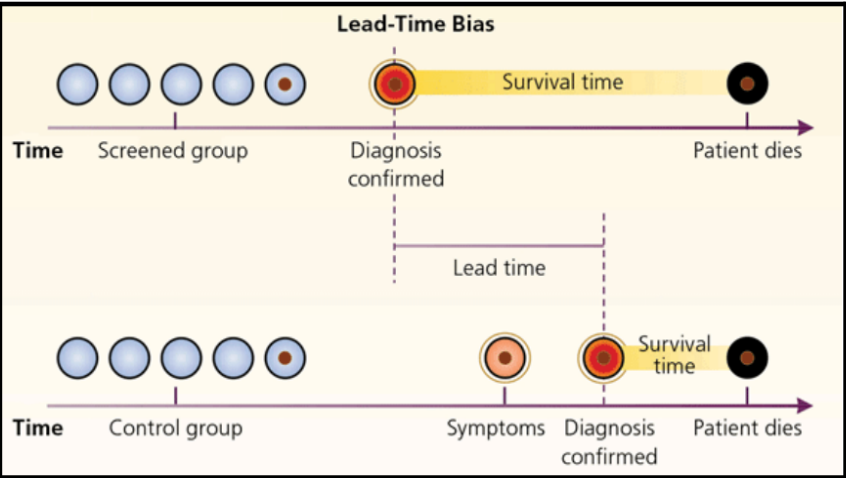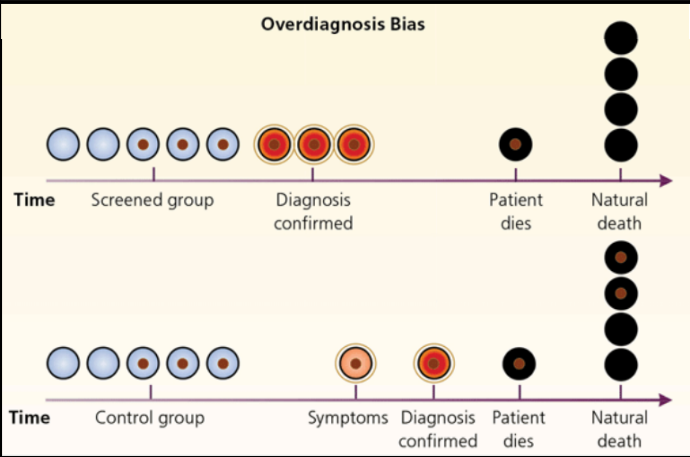Epi - Lecture 6 - Screening - 23/01
1/18
There's no tags or description
Looks like no tags are added yet.
Name | Mastery | Learn | Test | Matching | Spaced |
|---|
No study sessions yet.
19 Terms
screening definition
tests among asymptomatic people to identify those at an increased risk of a disease or disorder, who are offered a subsequent diagnostic test or procedure
3 types of prevention
primary → prevent disease or injury before it occurs
ban of asbestos, education about healthy habits
secondary → reduce impact of disease / injury that has already occured
screening
tertiary → soften the impact of an ongoing illness or injury
support group, rehabilitation programme
diagnostics versus screening
diagnostic tests are used to determine the presence or absence of a disease when a subject shows signs/symptoms of a disease
surveillance versus screening
surveillance tends to be a long-term close, continuous observation of an individual/population → screening is a short-term cross-sectional operation (BUT can be repeated) of a population at risk.
9 screening programs in the Netherlands
breast cancer
cervical cancer
colorectal cancer
prenatal screening for infectious disease (HIV, hepatitis)
prenatal screening for down syndrom, edwards, patau
screening for physical abnormalities
ultrasound scan for genetic disorders
newborn hearing test
newborn heel prick test
informed decision
people need to get the information to be able to weigh all the pro’s and con’s of participation against each other
natural history of a disease
progression of the disease over time in the absence of treatment
need to know this for screening correctly
4 stages of natural history of disease
stage of susceptibility
end of this stage is the exposure
stage of subclinical disease
where screening takes place
here the disease is asymptomatic
incubation period
latency period
between stage 2 and 3 onset of symptoms
after this the time of diagnosis
beginning of subclinical phase is the pathological changes
stage of clinical disease
stage of recovery, disability or death
lead time
amount of time which the diagnosis is early (time between usual diagnosis and diagnosis due to screening) → screening should lead to early diagnosis
no lead time screening programme will not be effective but not only this is enough
also need measurable improvements in morbidity and mortality
side effects of screening
inconvenient
unpleasant
expensive (mammagraphy)
involves some risks
leads to difficult decisions.
explain sensitivity
ability of a test to find those with the disease (true positives) → perfect sensitivity; everyone with positive result has the disease.
explain specificity
ability of a test to find those without the disease (true negatives) → perfect specificity; everyone with a negative result does not have the disease
4 measures to asses validity of a test
sensitivity → ability of a test to find those with the disease (true positives) → perfect sensitivity; everyone with positive result has the disease.
specificity → ability of a test to find those without the disease (true negatives) → perfect specificity; everyone with a negative result does not have the disease
positive predictive value → probability of being affected if there is a positive test result.
If the test result is positive, what is the probability that the person truly has the disease
negative predictive value → probability of being not affected if there is a negative test result.
calculation sensitivity, specificity
sensitivity = TP/ (TP + FN)
specificity = TN/ (TN + FP)
positive predictive value = TP/ (TP + FP)
PPV of 50% means that you have a 50% chance of having the disease and 50% chance of not having it
negative predictive value = TN/ (FN + TN)

calculation PPV, and NPT
positive predictive value = TP/ (TP + FP)
PPV of 50% means that you have a 50% chance of having the disease and 50% chance of not having it
negative predictive value = TN/ (FN + TN)

the 3 biases in screening
lead-time bias
overdiagnosis bias
length time bias
lead time bias
comparing survival times gives an incorrect assumption, because with and without screening gives the same outcome (the person that was diagnosed dies). person was only diagnosed earlier

overdiagnosis bias
error from detecting disease that would never have been found were it not for the screening test → people would normally die without ever knowing they have a certain disease, but due to screening these diseases may be detected, leading to an overdiagnosis of the disease → is negative, because treatments they receive can have side-effects, it can change courses of life → is the extreme of the length-time bias.
error from detecting the disease that would never have been found were it not for the screening test → in the first group, the survival rate is high (1/3), while in the second group 100% dies, BUT there is the same outcome (one person dies)

length time bias
error from detecting disease with a long latency of pre-clinical period → for aggressive diseases, there is a small window for detection without symptoms being present → for slow-growing tumors there is a longer time to detect the disease without any symptoms, therefore these are more likely to be detected as well → BUT, then screening seems to be responsible for higher survival rates, which might not be true.
a higher proportion of indolent/less aggressive tumors (easier to treat) is found in the screened group, causing an apparent improvement in survival → appears to be more positive outcomes. → avoid bias: do an RCT with an arm with and one without screening. Ethical considerations: (a) screening addresses asymptomatic people (so you are intervening in the life of healthy people) → (b) prevalence of diseases is usually low → (c) false-positive results can lead to anxiety → (d) false negative results lead to false reassurance → (e) info about the screening is key → (f) equity to screening (people that participate are often healthier, so need to involve vulnerable groups).
